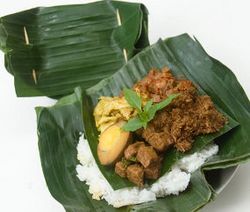Nasi bogana facts for kids

Nasi bogana wrapped inside banana leaf
|
|
| Course | Main course |
|---|---|
| Place of origin | Indonesia |
| Region or state | Tegal, Central Java |
| Serving temperature | Hot or room temperature |
| Main ingredients | Rice with side dishes wrapped inside banana leaf |
Nasi bogana (say nah-see boh-gâna) is a special rice dish from Indonesia. It comes from a place called Tegal in Central Java. This yummy meal is often wrapped in banana leaves. It comes with many different side dishes.
Nasi bogana is a type of nasi campur. This means it's a dish with rice and a mix of other tasty foods.
This rice dish is very popular in Indonesia. You can find it sold on the streets of Jakarta, the capital city. It usually costs between 12,000 and 20,000 rupiah. Many Sundanese or Javanese restaurants sell it. You can also find it in small, traditional outdoor restaurants called warungs or wartegs.
Nasi bogana is super handy because it's wrapped up. This makes it easy to take with you and eat anywhere. It's like a quick meal you can grab to eat at school or work.
Contents
How Nasi Bogana is Made
Making Nasi bogana starts with a wide banana leaf. Steamed rice is placed on top of it. Then, tasty seasonings like fried shallots are sprinkled over the rice.
Next, a smaller banana leaf is put on the rice. Then, lots of different side dishes are carefully placed around the rice. These often include:
- Opor ayam (chicken in a white coconut curry)
- Dendeng (shredded meat)
- Fried chicken liver and gizzard in a spicy coconut sauce
- Sambal (a spicy chili paste)
- Telur pindang (whole boiled eggs)
- Serundeng (fried shredded spiced coconut with peanuts)
- Sautéed tempeh (a soy cake) or sautéed string beans
After all the food is arranged, the outer banana leaf is folded over everything. Plastic strings are used to tie the package tightly. The wrapped meal is then put into a steamer to keep it warm. This way, it's ready to eat whenever you are hungry!
Sometimes, restaurants serve Nasi bogana without the banana leaves. This happens because the dish is so common now. Not all places follow the old traditions.
Making the Side Dishes
The opor ayam chicken is usually served without bones. This makes it easier to wrap inside the banana leaves. There are two main types of opor ayam. One has a white gravy, common in West Java. The other has a yellow gravy, common in Central Java. Both are a bit sweet. The yellow opor ayam often has more curry spices.
Dendeng (shredded meat) is sometimes put on a stick. You can eat it like a satay (meat on a skewer). The telur pindang boiled eggs are often cut in half. Only half an egg might be served, depending on the meal.
Other side dishes like serundeng, fried chicken liver and gizzard, sambal, and sautéed tempeh or string beans are served regularly. A spoonful of each is placed around the steamed rice.
Traditions and Culture
In Java, Nasi bogana is often part of special events. These include weddings and anniversaries. But it is most common at family get-togethers and social gatherings called arisan.
At weddings, Nasi bogana might have its own special area. Guests can choose their own side dishes and sauces there. Many people like to eat Nasi bogana with kerupuk (Indonesian crackers) or emping (bean crackers). These crackers become part of the meal's side dishes.
Some people also like extra sauces. These can be Kecap manis (sweet soybean sauce) or sambal terasi (a chili sauce with fish and shrimp). The usual drink with this meal is hot or iced black tea.
Nutrition Facts
Nasi bogana gives you protein from the meat and carbohydrates from the rice. It also has fats and oils. This is because coconut and palm oils are used to prepare many of the side dishes. Most of the side dishes are made by frying.
A single serving of Nasi bogana can have a lot of calories. It is similar to some fast food meals.
Other Indonesian Rice Dishes
Indonesia has many other delicious rice dishes, such as:
- Nasi campur
- Nasi gudeg
- Nasi jamblang
- Nasi Kapau
- Nasi kebuli
- Nasi krawu
- Nasi kuning
- Nasi langgi
- Nasi lemak
- Nasi liwet
- Nasi Megono
- Nasi Padang
- Nasi pecel
- Nasi timbel
- Nasi uduk
- Nasi ulam

